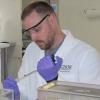In the interest of science -- and data regarding the process of making C60OO , please participate in the poll. Feel free to post as well.
I'm of the firm opinion as of now, that the issue with Kelsey's mice is one of food or olive oil contamination, or some other environmental issue, and has absolutely nothing to do with the C60 used. It could also be a de-novo mutation of the AML cell line used that caused it to be more invasive and robust.
PAHs, and other related volatile compounds are known contaminants of olive oil, and also known carcinogens in mice.
Have at it!
Edited by sensei, 13 August 2016 - 07:40 PM.



















































